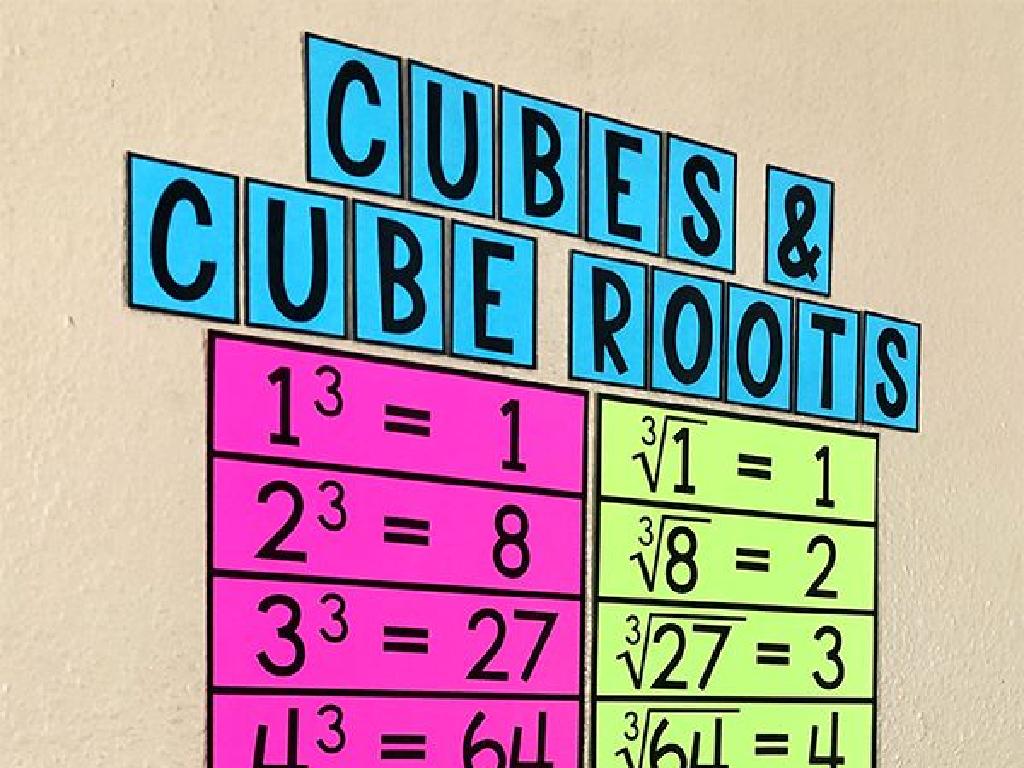Classify Numbers
Subject: Math
Grade: Eighth grade
Topic: Rational And Irrational Numbers
Please LOG IN to download the presentation. Access is available to registered users only.
View More Content
Welcome to Rational and Irrational Numbers
– Explore types of numbers
– Define rational numbers
– Ratios of integers, e.g., 1/2, 0.75, -8
– Define irrational numbers
– Cannot be expressed as ratios, e.g., 2, À
– Comparing characteristics
– Rational numbers are countable, irrationals are not
|
This slide introduces students to the fundamental concepts of rational and irrational numbers. Rational numbers are any numbers that can be expressed as a fraction or ratio of two integers, where the denominator is not zero. They can be whole numbers, fractions, and terminating or repeating decimals. Irrational numbers, on the other hand, cannot be written as simple fractions; their decimal expansions are non-repeating and non-terminating. Examples include the square root of non-perfect squares and pi (À). It’s crucial for students to understand that all integers are rational because they can be expressed as a ratio of themselves to one. Encourage students to think of rational numbers as ‘countable’ because they can be listed, whereas irrational numbers are ‘uncountable’ due to their non-repeating nature. This distinction is important for higher-level math concepts.
Understanding Rational Numbers
– Define rational numbers
– Numbers expressed as a fraction of two integers, e.g., 1/2, 3/4
– Examples of rational numbers
– 0.75, 2/3, -5, 0.333…
– Explore properties of rational numbers
– They can be written as fractions, have a decimal representation, and are countable
|
This slide aims to introduce students to the concept of rational numbers. Begin with the definition, emphasizing that any number that can be expressed as a fraction where both the numerator and the denominator are integers (and the denominator is not zero) is considered rational. Provide examples, including both positive and negative numbers, fractions, and decimals. Discuss properties such as the ability to convert between fractions and decimals, and that these numbers can be ordered on a number line. Highlight that all integers are rational because they can be expressed as a fraction with a denominator of 1. Encourage students to think of their own examples of rational numbers and consider how these numbers are used in everyday life.
Representing Rational Numbers
– Fractions as rational numbers
– A fraction a/b is rational if a and b are integers, and b is not zero.
– Decimals as rational numbers
– Decimals that terminate or repeat are rational.
– Converting fractions to decimals
– Divide the numerator by the denominator to convert.
– Rational numbers on a number line
– Points on the line correspond to rational numbers.
|
This slide introduces students to the concept of rational numbers, which include both fractions and decimals. Start by explaining that any number that can be expressed as a fraction where both the numerator and denominator are integers (and the denominator is not zero) is considered rational. Then, discuss how decimals are also rational if they either terminate (come to an end) or repeat a pattern. Demonstrate the process of converting fractions to decimals by division. Finally, illustrate how rational numbers can be identified and represented on a number line, reinforcing the concept that every point on the line corresponds to a rational number. Encourage students to practice these concepts with examples and exercises.
Understanding Irrational Numbers
– Define irrational numbers
– Numbers that cannot be expressed as a fraction of two integers
– Examples of irrational numbers
– Pi (À), the square root of 2 ( 2), and Euler’s number (e)
– Non-repeating, non-terminating decimals
– Decimals that go on forever without repeating a pattern
– Contrast with rational numbers
|
This slide introduces the concept of irrational numbers, which are numbers that cannot be written as a simple fraction, i.e., they cannot be expressed as a ratio of two integers. Provide examples such as Pi (À), the square root of 2 ( 2), and Euler’s number (e) to illustrate irrational numbers. Explain that these numbers have non-repeating, non-terminating decimal expansions, which means they go on forever without forming a repeating pattern. Highlight the difference between rational and irrational numbers by contrasting them with examples of rational numbers like 1/2 or 3/4, which have finite or repeating decimal representations. Encourage students to think of other examples and to explore decimal expansions to deepen their understanding.
Characteristics of Irrational Numbers
– Non-repeating, non-terminating decimals
– Decimals that don’t end or have a repeating pattern, e.g., Pi (À)
– Examples of famous irrational numbers
– Pi (À), Euler’s number (e), and the square root of 2 ( 2)
– Significance of irrational numbers
– They show up in various mathematical and scientific contexts
– Irrational numbers in the real number system
– They are part of the real numbers but cannot be written as fractions
|
This slide introduces students to the concept of irrational numbers, which are a type of real number that cannot be expressed as a simple fraction. This is because they have non-repeating and non-terminating decimal expansions. Examples like Pi (À), Euler’s number (e), and the square root of 2 ( 2) are not just mathematical curiosities; they play a significant role in fields such as geometry, calculus, and physics. Understanding where irrational numbers fit within the real number system helps students to grasp the full spectrum of numbers they will encounter in mathematics. Encourage students to explore the decimal expansions of these numbers and to consider why such numbers cannot be represented as a ratio of two integers.
Rational vs. Irrational Numbers
– Similarities of number types
– Both can be plotted on the number line
– Key differences highlighted
– Rational numbers are quotients of integers, unlike irrationals
– Tips to distinguish them
– Rational numbers terminate or repeat; irrationals do not
– Examples for clarity
– Rational: 1/2, 0.75; Irrational: 2, À
|
This slide aims to compare and contrast rational and irrational numbers. Emphasize that both types of numbers can be represented on a number line, which is a commonality. However, rational numbers can be expressed as a fraction of two integers (where the denominator is not zero), and either terminate or have a repeating pattern when written as decimals. In contrast, irrational numbers cannot be written as a simple fraction and their decimal form is non-terminating and non-repeating. Provide tips for distinguishing between the two, such as looking for patterns or trying to express the number as a fraction. Use clear examples to illustrate the points: for rational numbers, use simple fractions or decimals, and for irrational numbers, use square roots of non-perfect squares or the number À. Encourage students to practice by classifying numbers themselves and explaining their reasoning.
Class Activity: Classifying Numbers
– Practice classifying numbers
– Determine rational vs irrational
– Rational numbers can be expressed as a fraction, irrational cannot
– Group activity: find examples
– Each group finds real-life examples of both types of numbers
– Share examples with the class
– Discuss why each example is rational or irrational
|
This interactive class activity is designed to help students apply their knowledge of rational and irrational numbers in a collaborative setting. Begin by reviewing the definitions: rational numbers can be written as a fraction (e.g., 1/2, 0.75), while irrational numbers cannot be expressed as a simple fraction (e.g., the square root of 2, pi). Divide the class into small groups and assign each group the task of finding examples of both rational and irrational numbers, which could be from real-life situations or mathematical concepts. After the activity, regroup and have a representative from each group share their findings. Encourage discussion on why the examples fit into each category, reinforcing the concept through peer learning. This activity not only solidifies the students’ understanding but also enhances their collaborative and communication skills.
Conclusion: Rational vs. Irrational Numbers
– Recap: Rational & Irrational Numbers
– Rational numbers can be expressed as fractions, while irrational cannot.
– Significance of Number Classification
– Knowing the difference helps in various math fields like algebra & geometry.
– Real World Applications: A Glimpse
– Next, we’ll explore how these concepts apply to real-life scenarios.
– Engage with upcoming lessons
|
As we wrap up today’s lesson, it’s crucial to revisit the definitions and differences between rational and irrational numbers. Understanding these categories is foundational for higher mathematical concepts and problem-solving. Emphasize the practicality of this knowledge in fields such as engineering, finance, and science. Preview the next lesson by giving examples of how number classification is used in everyday situations, such as measuring distances or calculating interest rates. Encourage students to think of examples they might encounter outside of school to prepare them for the next class.
Homework: Mastering Number Classification
– Complete the worksheet on number classification
– List examples of rational and irrational numbers
– Rational: fractions like 1/2, decimals that end or repeat. Irrational: 2, À
– Solve practice problems for reinforcement
– Focus on identifying and classifying numbers correctly
– Be ready to discuss your examples in class
|
This homework assignment is designed to solidify students’ understanding of rational and irrational numbers. The worksheet will provide a structured approach to classifying numbers, while listing examples will help students apply the concept to real numbers. Encourage students to include a variety of examples, such as terminating and repeating decimals for rational numbers, and non-repeating, non-terminating decimals for irrational numbers. The practice problems will serve as additional reinforcement, ensuring that students can confidently identify and classify numbers. During the next class, students will engage in a discussion to share their examples and reasoning, promoting a deeper understanding through peer learning.




